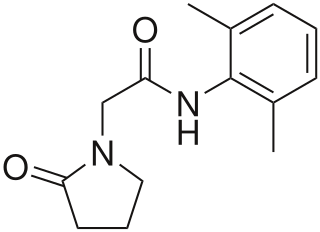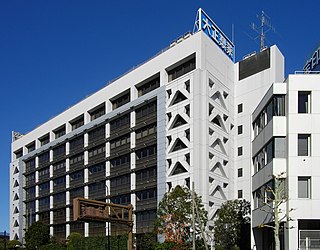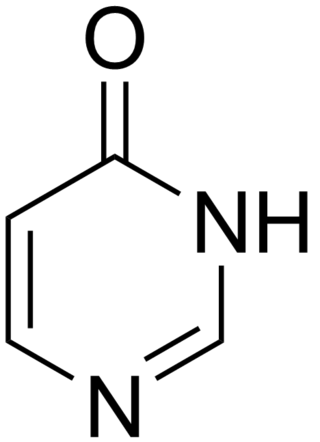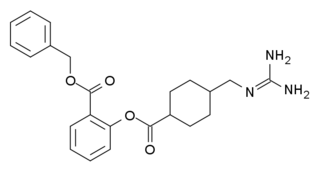H1 antagonists, also called H1 blockers, are a class of medications that block the action of histamine at the H1 receptor, helping to relieve allergic reactions. Agents where the main therapeutic effect is mediated by negative modulation of histamine receptors are termed antihistamines; other agents may have antihistaminergic action but are not true antihistamines.

Hep G2 is a human liver cancer cell line.

Nefiracetam is a nootropic drug of the racetam family. Preliminary research suggests that it may possess certain antidementia properties in rats.
Palifermin is a truncated human recombinant keratinocyte growth factor (KGF) produced in Escherichia coli. KGF stimulates the growth of cells that line the surface of the mouth and intestinal tract.

Taisho Pharmaceutical Co., Ltd., commonly known as Taisho, is a Japanese multinational pharmaceutical company based in Tokyo.

Proglumide (Milid) is a drug that inhibits gastrointestinal motility and reduces gastric secretions. It acts as a cholecystokinin antagonist, which blocks both the CCKA and CCKB subtypes. It was used mainly in the treatment of stomach ulcers, although it has now been largely replaced by newer drugs for this application.

Pyrimidone is the name given to either of two heterocyclic compounds with the formula C4H4N2O: 2-pyrimidone and 4-pyrimidone. The compounds can also be called 2-hydroxypyrimidine or 4-hydroxypyrimidine respectively, based on a substituted pyrimidine, or 1,3-diazine, ring.

Benexate (BEX) is an anti-ulcer agent used in the treatment of acid-related disorders. It is unique in its inability to form salts that are both non-bitter and soluble.

Cetraxate (INN) is an oral gastrointestinal medication which has a cytoprotective effect.

Troxipide is a drug used in the treatment of gastroesophageal reflux disease. Troxipide is a systemic non-antisecretory gastric cytoprotective agent with anti-ulcer, anti-inflammatory and mucus secreting properties irrespective of pH of stomach or duodenum. Troxipide is currently marketed in Japan (Aplace), China (Shuqi), South Korea (Defensa), and India (Troxip). It is used for the management of gastric ulcers, and amelioration of gastric mucosal lesions in acute gastritis and acute exacerbation of chronic gastritis.
An enzyme inducer is a type of drug that increases the metabolic activity of an enzyme either by binding to the enzyme and activating it, or by increasing the expression of the gene coding for the enzyme. It is the opposite of an enzyme repressor. There are specific types of enzyme inducers that create cytoprotective pathways that play a role in prevention and treatment of cancer and other diseases including cardiovascular disease and neurodegenerative diseases. Enzyme inducers can be either naturally occurring or synthetically made.

Piperoxan, also known as benodaine, was the first antihistamine to be discovered. This compound, derived from benzodioxan, was prepared in the early 1930s by Daniel Bovet and Ernest Fourneau at the Pasteur Institute in France. Formerly investigated by Fourneau as an α-adrenergic-blocking agent, they demonstrated that it also antagonized histamine-induced bronchospasm in guinea pigs, and published their findings in 1933. Bovet went on to win the 1957 Nobel Prize in Physiology or Medicine for his contribution. One of Bovet and Fourneau's students, Anne-Marie Staub, published the first structure–activity relationship (SAR) study of antihistamines in 1939. Piperoxan and analogues themselves were not clinically useful due to the production of toxic effects in humans and were followed by phenbenzamine (Antergan) in the early 1940s, which was the first antihistamine to be marketed for medical use.

Tolimidone is a compound which was discovered by scientists at Pfizer, was found to stimulate secretion of gastric mucosa, and was in development by Pfizer as a drug candidate to treat gastric ulcers but was abandoned. After the patent on the compound expired, scientists at the company Melior Discovery identified it as a potential drug candidate for diabetes through a phenotypic screen. The company proceeded to show that MLR-1023 is an allosteric activator of Lyn kinase with an EC50 of 63 nM. As of 2012 Melior was repurposing it for diabetes. In June 2016, the company reported positive results from their Phase 2a clinical study in diabetic subjects
Cytoprotection is a process by which chemical compounds provide protection to cells against harmful agents.
Gaseous mediators are chemicals that are produced in small amounts by some cells of the mammalian body and have a number of biological signalling functions. There are three so-far-identified gaseous mediator molecules: nitric oxide (NO), hydrogen sulfide (H2S), and carbon monoxide (CO).
Mucoprotective agents are pharmaceutical or herbal medicines that protect mucous membrane tissues. They include such things as demulcents.

Aceglutamide, or aceglutamide aluminium, also known as acetylglutamine, is a psychostimulant, nootropic, and antiulcer agent that is marketed in Spain and Japan. It is an acetylated form of the amino acid L-glutamine, the precursor of glutamate in the body and brain. Aceglutamide functions as a prodrug to glutamine with improved potency and stability.

Catechin-7-O-glucoside is a flavan-3-ol glycoside formed from catechin.

Atranorin is a chemical substance produced by some species of lichen. It is a secondary metabolite belonging to a group of compounds known as depsides. Atranorin has analgesic, anti-inflammatory, antibacterial, antifungal, cytotoxic, antioxidant, antiviral, and immunomodulatory properties. In rare cases, people can have an allergic reaction to atranorin.
Plaunotol (18-hydroxygeranylgeraniol) is a chemical compound with the molecular formula C20H34O2. It is a diterpene that was first isolated from Croton sublyratus.













